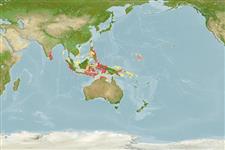Common names from other countries
Classification / Names
आम नाम | उपशब्द | Catalog of Fishes(वर्ग, प्रजाति) | ITIS | CoL | WoRMS | Cloffa
>
Gobiiformes (Gobies) >
Gobiidae (Gobies) > Gobiinae
Etymology: Eviota: No etymology given, suggested by Christopher Scharpt: from Latin 'eu' for 'true' and 'iota' for anything very small, in combination 'truly very small' referring to it as being the smallest vertebrate at the time it has benn described by Jenkins (thus, making the suggestion by Scharpt plausible.; rubriceps: Name from combining the Latin rubrum (red) and caput (head), referring to the distinctive red head in life; an adjective..
More on authors: Greenfield & Jewett.
Environment: milieu / climate zone / depth range / distribution range
पारिस्थितिकी
समुद्री बेनथोपिलाजिक; गहराई सीमा 0 - 17 m (Ref. 88933). Tropical
Indo-Pacific: Indonesia (Raja Ampat Islands, Halmahera, Banda Islands, Molucca Islands, West Papua), Papua New Guinea (Bismark Archipelago), and Philippines (Palawan).
आकार / वज़न / Age
Maturity: Lm ? range ? - ? cm
Max length : 1.4 cm SL पुल्लिंग / अलिंग; (Ref. 88933)
Short description
पहचान कुंजी | आकृति विज्ञान | मौरफोमैटरिक्स
पृष्ठीय रीढ़ (सम्पूर्ण) : 7; पृष्ठीय सौफट रेज़ (सम्पूर्ण) : 8; गुदा कांटा: 1; ऐनल सौफट रेज़: 7 - 8; जानवरों की रीड़ का जोड़: 25. This species is distinguished from its congeners by the following set of characters: cephalic sensory-pore system pattern 2 (only IT pore missing); dorsal/anal fin-ray formula almost always 8/7; pectoral-fin rays unbranched; first three dorsal spines may be filamentous in males; 5th pelvic-fin ray absent or rudimentary to 20% maximum of 4th ray; strong black pigment along scale pockets on ventral two-thirds of sides and peppering of dark chromatophores on nape and upper back when preserved; snout, top and sides of head red in life; dark area of abdomen not crossed by a curved yellow-gold line in life (Ref. 88933); characterized further by longitudinal scale series 21-24; scales ctenoid, none on head, breast and pectoral fin base; depth of body 4.2-5.6 in SL (Ref. 90102).
Life cycle and mating behavior
Maturities | पुनरुत्पत्ति | Spawnings | Egg(s) | Fecundities | लार्वा
Greenfield, D.W. and S.L. Jewett, 2011. Eviota rubriceps, a new goby from the Southwestern Pacific Ocean, with comments on E. mikiae and E. raja (Teleostei: Gobiidae). Zootaxa 3134:53-62. (Ref. 88933)
IUCN Red List Status (Ref. 130435)
CITES (Ref. 128078)
Not Evaluated
Threat to humans
Harmless
Human uses
साधन
Special reports
Download XML
इंटरनेट स्रोत
Estimates based on models
Preferred temperature (Ref.
115969): 27.4 - 29.3, mean 28.7 (based on 990 cells).
Phylogenetic diversity index (Ref.
82804): PD
50 = 0.5000 [Uniqueness, from 0.5 = low to 2.0 = high].
Bayesian length-weight: a=0.00708 (0.00333 - 0.01504), b=3.09 (2.92 - 3.26), in cm Total Length, based on LWR estimates for this (Sub)family-body shape (Ref.
93245).
Trophic level (Ref.
69278): 3.0 ±0.3 se; based on size and trophs of closest relatives
Fishing Vulnerability (Ref.
59153): Low vulnerability (10 of 100).
